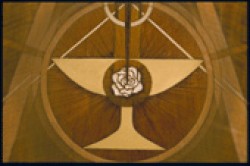|
|
|
| Timelessness of the Grail |
 The Grail is the most mysterious secret of the Middle Ages. Its origin is lost in the night of time. Like all the sacred symbols, the Grail has powerfully marked the inner conscience of a time fond of spirituality and elevation; and this because it evoked purity and revelation, sacrifice and perfect healing. The Grail is the most mysterious secret of the Middle Ages. Its origin is lost in the night of time. Like all the sacred symbols, the Grail has powerfully marked the inner conscience of a time fond of spirituality and elevation; and this because it evoked purity and revelation, sacrifice and perfect healing.
The Holy Cup goes from mouth to mouth, travels from tradition to tradition. It is the magic cauldron of the Celtic druids. It appeared in Persia, reappeared among the first Gnostic Christians and the Manicheans and then animated the medieval Gnosis.
It may be found in Wales (Glastonbury), in Fécamp and Bruges, on the Rhine river and above all in the Pyrenees, the North of Spain and the Languedoc.
The word ‘Grail’ comes from ‘grasal’, which means in the Occitan language a vase of clay or a large cup. The Knights Templars talked about the ‘Sant Grésal’ or ‘Sant Gréal’.
The most ancient versions of the legend in the Occident are:
‘Perceval, the Story of the Grail’ by Chrétien de Troyes (1150–1191)
and ‘Parzifal’ and ‘Titurel’ by Wolfram von Eschenbach (1170–1220).
|
 |
|
|
|
|




